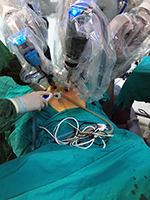
Most of us haven't had surgery and even if we had, no robots were likely involved. But that will change. Recently one robot assisted surgery really stood out when a robot precisely cut a hole in a skull. That in itself wasn't remarkable except that it took just two and a half minutes compared to a human surgeon's two hours. This was a game changer.
Robot assisted surgery is now used in orthopedics, obstetrics, otolaryngology, and other specialties. The main reason is that it helps cut down surgical and recovery time, results in fewer errors, and costs less. In the case of neurosurgery, cutting down the time that a hole is open in a patient's skull lowers the risk of infection.
The drill is computer controlled and guided by a two dimensional CT scan that can create a 3D image of the area. The surgeon then indicates where the hole should be made as well as the axis, radius and depth and then the software calculates the ideal path for the drill to take. This path includes a margin of safety around all important structures that must be avoided. Safety features include an emergency off switch in case of a difficulty such as an alert from the device indicating a facial nerve is near.
The device was tested on plastic blocks then on a cadaver. When compared with a manual drill, the robot drill was more accurate and fifty times faster. The bonus is the robotic drill device is relatively inexpensive, at less than a hundred thousand bucks and is already headed for production. It's among the growing field of robot assisted surgery which no doubt will help improve patient outcomes.
More Information
This Robot Completes a 2-Hour Brain Surgery Procedure in Just 2.5 Minutes
Researchers believe their surgery-assisting robot is capable of performing complex brain surgeries. The machine can reduce the time of surgeries by cutting down the time it takes to cut into the skull from two hours to two and a half minutes...
History and the future of Robotic Surgery
The first documented use of a robot-assisted surgical procedure occurred in 1985 when the PUMA 560 robotic surgical arm was used in a delicate neurosurgical biopsy, a non-laparoscopic surgery...
Computer-aided design/computer-aided manufacturing skull base drill
Automation in the field of surgery has been growing in the past decade. Medical robots have been built to assist in critical surgeries in diverse specialties such as orthopedic surgery (hip replacement), spine surgery (pedicle screw placement, vertebroplasty), and otorhinolaryngology (implantation of hearing aid devices), among others. Despite the advances in medical robotics, many surgical procedures continue to be performed manually by surgeons and are therefore more time consuming, adding to surgical expense, and are susceptible to human error. In many cases, robot assistance could reduce the overall duration of surgeries as well as minimize human error and the cost of surgery...